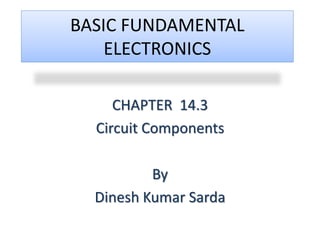
Basic Fundamental Electronics by D-Sarda PART III
- 1. BASIC FUNDAMENTAL ELECTRONICS CHAPTER 14.3 Circuit Components By Dinesh Kumar Sarda
- 2. Open and Short Circuits • An open circuit between A and B means i=0. • Voltage across an open circuit: any value. • An open circuit is equivalent to R = ∞ Ω. • A short circuit between A and B means v=0. • Current through a short circuit: any value. • A short circuit is equivalent to R = 0 Ω. Copyright © 2013 The McGraw-Hill Companies, Inc. Permission required for reproduction or display. 2
- 3. LSU 08/11/2004 Electronics 2 3 Inductors Values specified in henries (H), millihenries (mH) and microhenries (μH) A coil of wire that may be wound on a core of air or other non-magnetic material, or on a magnetic core such as iron powder or ferrite. Two coils magnetically coupled form a transformer.
- 4. LSU 08/11/2004 Electronics 2 4 Inductor types Molded inductor & air-wound inductor Adjustable air-wound inductor Ferrite core toroidal transformer Iron powder toroidal inductorAir wound inductor
- 5. LSU 08/11/2004 Electronics 2 5 Inductor ratings Wire gauge and physical size of the coil determine the current handling capacity. Core material will have a temperature dependence. Air is best, followed by iron powder, then ferrites.
- 6. Bread Board VS Print Circuit Board(PCB)
- 7. Non Customized Vs Customized
- 8. Integrated Circuits Integrated circuits (ICs) are multi-terminal devices that provide an array of functions and applications far too numerous to list here.
- 9. Pin identification and numbering convention Pins are numbered sequentially in a counterclockwise direction. Pin 1 is often identified with a dot or a dimple. Notch Dimple Pin 1 Pin 7 Pin 8 Pin 14
- 10. SI: Units and Prefixes Any measurement can be expressed in terms of a unit, or a unit with a “prefix” modifier. Example: 12.3 mW = 0.0123 W =1.23 x 10-2 W Copyright © 2013 The McGraw-Hill Companies, Inc. Permission required for reproduction or display. 10 FACTOR NAME SYMBOL 10-9 nano n 10-6 micro μ 10-3 milli m 103 kilo k 106 mega M
- 11. Using a multi meter to make resistance and voltage measurements
- 12. Multimeter: a device with two probes (red (positive) and black (negative)) with which one can make resistance, voltage, and current measurements – for resistance and voltage measurements (all we’ll be doing in this class) always plug the black probe into the socket labeled “COM” and the red probe into the socket labeled “V Ω mA”
- 13. Measuring resistance in Ohms (Ω). Turn the dial to a value on the Ohms scale larger than the resistance you expect. Touch the two probes to either end of the resistor (preferably when it is not part of any circuit, lest there be alternate current paths around the resistor). Adjust the dial downwards as necessary. Read the value of the resistance in Ohms, kiloOhms, or MegaOhms. (Note – you can also read off resistance values by using resistor color codes.)
- 14. Measuring DC voltage (i.e. battery-type voltage). Turn the dial to a value on the DC Volts scale larger than the voltage you expect. Touch the two probes to the two points on the circuit between which you want to know the voltage change, trying to put the black probe on the point with the lower voltage (i.e. closer to “ground”). Adjust the dial downwards as necessary and read off the value in volts. Notice that the reading is the voltage drop from the red (positive) probe to the black (negative) probe, so a positive reading means that the red probe is indeed at a more positive voltage than the black probe. On the other hand, a negative reading means the red probe is more negative than the black probe. (See next slide for photos of a voltage reading being made.)
- 15. TRANSISTORS “The building blocks of electronics world”
- 16. How does Transistor Look Like ??
- 18. The first transistor In 1947, John Bardeen and Walter Brattain deviced - the first "point contact" transistor.
- 19. Moore’s Law It’s an observation made by Gordon E. Moore, in which he predicted that the number of transistors, inside an Integrated Circuit, could be doubled every 24 months. At the density that also minimized the cost of a transistor.
- 20. Transistor Definition • Transistor is an electronic device made of three layers of semiconductor material that can act as an insulator and a conductor. • The three layered transistor is also known as the bipolar junction transistor.
- 21. Bipolar Junction Transistors (BJT’s) • The term bipolar refers to the use of both holes and electrons as charge carriers in the transistor structure • There are two types of BJTs, the NPN and PNP
- 23. Regions of a transistor • A transistor has three regions namely, • Emitter- heavily doped • Base- lightly doped • Collector- moderately doped
- 24. Transistor symbols Transistor symbols
- 25. Transistor operation force – voltage/current water flow – current - amplification
- 26. Transistor biasing • The base-emitter (BE) junction is forward biased • The base-collector (BC) junction is reverse biased. IE=IB+IC
- 27. Operating regions of BJT Cut off region Linear region Saturation region
- 28. Types of transistor • BJT - Bipolar Junction Transistor • UJT- Unipolar Junction Transistor • FET - Field Effect Transistor • MOS - Metal Oxide Semiconductor
- 29. Transistor applications Transistor as a switch When used as an electronic switch, the transistor is normally operated alternately in cut-off and saturation regions.
- 30. Transistor as amplifier • Due to the small changes in base current the collector current will mimic the input with greater amplitude
